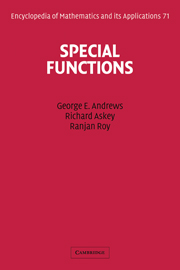Book contents
- Frontmatter
- Contents
- Preface
- 1 The Gamma and Beta Functions
- 2 The Hypergeometric Functions
- 3 Hypergeometric Transformations and Identities
- 4 Bessel Functions and Confluent Hypergeometric Functions
- 5 Orthogonal Polynomials
- 6 Special Orthogonal Polynomials
- 7 Topics in Orthogonal Polynomials
- 8 The Selberg Integral and Its Applications
- 9 Spherical Harmonics
- 10 Introduction to q-Series
- 11 Partitions
- 12 Bailey Chains
- A Infinite Products
- B Summability and Fractional Integration
- C Asymptotic Expansions
- D Euler–Maclaurin Summation Formula
- E Lagrange Inversion Formula
- F Series Solutions of Differential Equations
- Bibliography
- Index
- Subject Index
- Symbol Index
12 - Bailey Chains
Published online by Cambridge University Press: 05 May 2013
- Frontmatter
- Contents
- Preface
- 1 The Gamma and Beta Functions
- 2 The Hypergeometric Functions
- 3 Hypergeometric Transformations and Identities
- 4 Bessel Functions and Confluent Hypergeometric Functions
- 5 Orthogonal Polynomials
- 6 Special Orthogonal Polynomials
- 7 Topics in Orthogonal Polynomials
- 8 The Selberg Integral and Its Applications
- 9 Spherical Harmonics
- 10 Introduction to q-Series
- 11 Partitions
- 12 Bailey Chains
- A Infinite Products
- B Summability and Fractional Integration
- C Asymptotic Expansions
- D Euler–Maclaurin Summation Formula
- E Lagrange Inversion Formula
- F Series Solutions of Differential Equations
- Bibliography
- Index
- Subject Index
- Symbol Index
Summary
L. J. Rogers is the pioneer of the work leading to the Rogers–Ramanujan identities and beyond. His idea, published in Rogers [1917], provides the starting point for the work of this chapter. We shall recount his seminal idea in Section 12.1. In the 1940s, W. N. Bailey began a systematic study of identities of the Rogers-Ramanujan type. See Bailey [1949]. He saw great generality in the methods introduced by Rogers. This greater level of generality provides for a wide variety of applications well beyond those considered by Rogers.
Motivation for the techniques presented here is scant. As you will see, Rogers's original idea seems almost magical in its construction. Since the advent of computer algebra we can better see how to make sense of Rogers's fortuitous discoveries. However, it is still not evident why one would initially expect that this method would bear fruit.
A systematic account of Bailey's ideas leading up to Bailey's lemma is given in Section 12.2. As an application of these ideas, the important 8ϕ7 transformation formula of Watson is derived in the next section. A few consequences of this formula are also included. The last section makes passing mention of other applications of the ideas in Section 12.2.
Rogers's Second Proof of the Rogers–Ramanujan Identities
The Rogers–Ramanujan identities were first discovered by Rogers [1894]. Rogers made considerable contributions to several areas of mathematics but surprisingly his work went largely unnoticed and did not have the influence it should have had.
Information
- Type
- Chapter
- Information
- Special Functions , pp. 577 - 594Publisher: Cambridge University PressPrint publication year: 1999
